Recent Articles
Popular Makes
Body Types
2006 Honda Ridgeline First Drive
A truck you can live with

Once upon a time, there lived a family of three bears in need of a new set of wheels. The Poppa Bear, a burly fella who enjoyed dirt bike riding in the desert, liked big and tough trucks. He despised cars, but his wife didn’t like frivolous waste. Yes, the mother bear was a practical lady who appreciated efficiency, fuel economy, and was partial to cars well built with good safety features. The little she-cub didn’t care one way or another as long as her porridge was warm and her bed was soft. After much hibernating on what to buy, the Bear family purchased a 2006 Honda Ridgeline. Later, while taking part in a Detroit-based consumer focus group, Poppa Bear growled and told the man that well, the Ridgeline was everything the Bear family needed and wanted, no more, no less. Smartly built and innovative, the Honda Ridgeline was the perfect truck for the suburban lifestyle. And then, Poppa Bear asked why the automakers that had been building trucks for decades could not come up with a vehicle like the Ridgeline. Oops. While this bear family may be a take on a classic tale, the point is the same: the 2006 Honda Ridgeline is not too big, not too small and not too rough – for many families, it’s just about right for what they need from a truck. As a result, the Ridgeline is a ruler slap across the cheek of Detroit’s Truck Nation. Right now, nothing really like the Ridgeline, so fellas, better get those rebate checks written for the Ranger, Dakota and the Colorado.
Value
Don’t count on Honda to put dollars on the hood of the Ridgeline. This truck needs a rebate like it needs a recall, as it is positioned for maximum value from the base model to the top trim. In fact, the 2006 Honda Ridgeline is one of the few vehicles on the road where the best buy may well be the least expensive truck, because the mid-level and top versions add only interior accessories we can all live without. Think of it: the truck that does everything is selling for less than $28,000. You don’t need the leather. Forget a navigation system – go buy a map. And finding a better deal at another dealer’s lot may be quite a challenge. While Honda does not consider the Ridgeline to be a competitor against big boys like the Chevrolet Silverado, Ford F-150 and Nissan Titan, if you’re in the midsize truck market, you will be hard-pressed to find a better combination of driveability, utility and off road capability. That spells value, and to that the Ridgeline adds innovative new features such as a trunk under the bed.. With a decent tow rating and a ride that is more car-smooth than truck-rough, the Ridgeline will compete with the likes of the Chevrolet Colorado, Ford Explorer SportTrac, Nissan Frontier and Toyota Tacoma. It will also compete against larger lifestyle trucks such as the Chevrolet Avalanche, and may well compete with smaller SUVs, too, like the Ford Escape, Jeep Liberty and Nissan Xterra. For now, it will do its competing with three choices, priced at $27,700 for the RT up to $31,490 for the top line RTL. The base RT version offers standard equipment such as anti-lock brakes with Electronic Brake Assist, Vehicle Stability Assist with Traction Control, advanced dual-stage, dual-threshold driver's and front passenger's Supplemental Restraint System (SRS) airbags, driver's and front passenger's side airbags, two-row side curtain airbags with rollover sensor and a tire pressure monitoring system. Additional standard features include the 255-horsepower Variable Valve Timing and Lift Electronic Control (VTEC, 3.5-liter V6 engine; five speed automatic transmission; Variable Torque Management four-wheel drive system; air conditioning; tilt steering wheel; power side windows, power sliding rear window and door locks; cruise control; keyless entry; automatic heated wiper zone; six speaker 100-watt audio system with CD player; 60/40 split lift-up rear seat with underseat storage and all-weather floor mats. All models come equipped ready to tow with standard transmission and oil coolers, heavy duty brakes, dual radiator fans, and pre-wiring for four and seven pin trailer hook up. The 2006 Honda Ridgeline RTS, at $30,075 adds alloy wheels, a seven speaker 160-watt audio system with subwoofer and six-disc CD changer with steering wheel controls, dual zone automatic climate control and an eight-way power driver's seat. The Ridgeline RTL adds leather seating surfaces, HomeLink remote system, an interior compass in the rearview mirror and heated front seats and an available power moonroof. Models with the power moonroof are equipped with standard satellite radio and are available with the Honda satellite-linked navigation system.
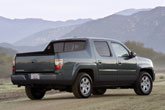
Interior
Arguably, Honda builds among the best interiors in the business, and the Ridgeline takes that pedigree and runs with it. The seats are firm and the material feels like it will wear well; the instrumentation design is simple and clean; plastics go together and components fit well. There are soft touch surfaces where they count. This is simplicity defined by class-leading materials and assembly. Environmental and stereo controls are organized in their layout and based on three large aluminum knobs. These knobs are easy to use, and you can feel a heft to the dial when you change the temperature. With most of the controls designed around these dials and a few necessary buttons, clutter is virtually non-existent and the result is a grouping of instruments that are exceedingly easy to use and nice to look at. Driver gauges are big and obvious and carry through the circular theme. There are plenty of vents for driver and passenger, and the Ridgeline has two large outlet flip-up tops below the environmental controls. The outlets are a reminder that yes, this is a truck you’re riding in – and people do use these things for rough and dirty duty.There are a few misses, however -- namely the large inside door handles designed to evoke memories of your favorite power tool. And while they're great to hang onto, they seem garishly out of place. Hard plastics abound, too, but then this is a truck, right? The truck side of the Ridgeline is more apparent in the back row. Here, the real emphasis is on cargo and convenience, though a short ride in back was comfortable. The seat backs are at a slightly angled degree thought by Honda to be ideal for most people. It's probably right on the mark, but people tend to be funny about their seat positions. Ultimately, Honda designed the back to accommodate bikes and people. The real headline is when you flip up the seats – a very easy maneuver – and realize how much room is available to stow belongings. The floor seat rail, which locks down seats when down, doubles as a bike rail. With seats up, the back is large enough to fit a typical bicycle, and the rail keeps it locked down in one place. After all, it is a truck – it does have a bed – and carting around bikes or other forms of cargo is a primary obligation. From the inside, though, the Ridgeline feels like a car -- the overall quality of the interior eliminates many of the notorious, roughhewn interior compromises that can come with truck ownership. It’s as if you’re not really driving a truck – through the magic of paint and metal, it only looks like you’re driving a truck. You’re really driving an Accord that can tow 5,000 lbs. and has a large composite basket on its hood. It could happen. From seat quality to materials, fit and finish and design, the interior of the 2006 Honda Ridgeline sets the bar at a height some of the competition will have trouble reaching.
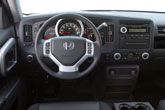
Exterior
The look of the 2006 Honda Ridgeline may well appeal to many people, but it does take a little getting used to. It twists and melts the classic truck lines and changes the design we expect to see into a futuristic design that is instantly intriguing, daring and, well, strange. From the back, the Ridgeline looks sharp, with the angled top of the bed slamming down from the back window and carrying its line to the bed of the truck. The front is aggressive and bold, with an extra large H grille, integrated headlights and a hood that represents a strong front profile for the Ridgeline. This part of the truck really does look like it was stamped out of metal. The sides also express strength and power, though the high, slanted bed is what gives the eye pause. Give Honda credit for building something that’s an interpretation of what has traditionally been a boring, three-box design, for merging the boxes and coming up with something daring. Chances are, the Ridgeline’s look will appeal to the core market for this truck – suburbanites who want something more rugged than a SUV with which to haul their lifestyle, yet one not as impractical as a work truck that gets bad gas mileage and can’t fit in the local store’s parking spaces. Time, and sales, will tell. In the meantime, go ahead and call it a wedge. Say it has been stamped out of a block of aluminum. Claim that it looks strong and bold. It still looks strange to me.
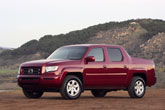
Driveability
The 2006 Honda Ridgeline drives, well, like you would expect a Honda to drive. But before you cough and say – ack – it’s a truck – consider the source: this is the Honda truck, not a rock pounding, teeth chattering traditional truck. And while your brain tells you that it is, indeed, a truck, while driving down the road your senses shout that you’re really in a car, a Honda car, too, and that someone may have stolen your truck right from under your nose.Really. On asphalt, the Ridgeline rides smooth like a Honda sedan – only taller, bigger and more powerful. The reason the Ridgeline is like a car in its paces is because it uses a suspension setup normally reserved for a car – a front and rear independent suspension that eliminates the kind of compromises many trucks suffer from, namely rear control under load and ride quality. Typically, trucks require a solid rear suspension to handle towing requirements, but Honda engineers were able to get 5,000 lbs. of tow capacity out of an independent rear suspension by designing a larger fresh air intake system, along with transmission and power steering coolers. There’s also a dual fan radiator. Honda engineers devised a hybrid type of frame on which to build the Ridgeline. Instead of the traditional ladder steel frame, on which the three main elements of a truck are built – nose, cab and bed – Honda took a unibody frame and welded a steel frame onto it, making cab and bed one piece and creating separate sections for the front and rear suspension. Honda claims that the resulting truck frame reduces body twist significantly, an important improvement when it comes to ride quality, load capacity and towing. Judging from two days of on and off road testing, the engineering works incredibly well. When combined with Honda’s 255-horsepower 3.5-liter V6, the ride is powerful, quiet and smooth. Through autocross courses with load and without, on highway and rural roads, in traffic and in mud, the Ridgeline stayed in line and under control. It is an exceedingly easy truck to drive, with plenty of visibility and command of the road. The V6 is the same engine that powers the 2005 Honda Pilot, which weighs about the same, so the engine does not feel as though it is under a heavy weight load. Before you think it's just a Pilot with a truck bed, however, think again: in order to reach standards in payload hauling, towing, performance and driving with loads, engineers made significant changes -- including the frame, intake and radiator enhancements mentioned above. All told, they claim that 93 percent of the Ridgeline is unique. Off the road, the 2006 Honda Ridgeline is capable, and the fully-automatic Variable Torque Management System (VTMS) handles most every type of condition most people are likely to encounter, such as dirt roads, snow, mud and hill climbs. During our testing, we were able to scale a 28-degree dirt and sand hill without much trouble -- as long as we got a good head start and remembered to turn the VTMS on and turn off the Ridgeline's vehicle stability control. With the vehicle stabilty control on, the Ridgeline will self-correct the vehicle and neutralize the torque management. We were able to navigate water pits, rough roads and more. In addition to the VTMS, the Ridgeline has 8.2 inches of ground clearance, a 25-degree approach angle, a 22-degree departure angle, and a 21-degree breakover angle for negotiating rough terrain. Granted, when it comes to off-road prowess the Ridgeline is not on par with trucks such as the new Nissan Frontier or Toyota Tacoma, and the ground clearance may not seem enough -- but it is enough for most normal off-road endeavors.

Wrap
Innovation is what the Ridgeline is all about, starting with the vehicle's engineering and extending to elements like the back seat bike rail, a dual-action lift gate, a fully composite bed supported by steel reinforcements and – believe it or not – an trunk under the truck bed. Yep, there’s a trunk back there, it’s lockable and is large enough to take a stroller or a couple of golf bags. Made possible by the type of suspension used -- a rear independent suspension takes up less room -- the trunk is sure to be a strong selling point. Built with composite material and a drain plug, the trunk also doubles as its own cooler, perfect for tailgate parties. About that tailgate. Designed for ease of use, the Ridgeline tailgate opens down as expected and out like a door, and can still hold about 300 lbs. when down. The bed itself can fit a 4x8 piece of plywood flat, which increases cargo space at the home improvement store,though there is no extender available.
It likely won't be missed. With its innovative new features, superb ride, acceptable tow rating and solid payload capacity, even a sleepy bear can see that the Ridgeline is convenience and usability defined by a truck, built by Honda and soon to be driven in and out of suburbs -- and a cave or two -- across America.
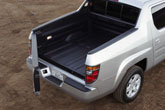
FAQs
Is the 2006 Honda Ridgeline a real truck? Yes. The Ridgeline can tow up to 5,000 lbs., plenty for most non-work truck application, and can manage a load in the bed with some much larger trucks. The difference is in the way the truck is built: instead of providing more capacity than a typical owner needs, the Ridgeline achieves typical use and, as a result, is able to engineer a better ride. What did you like most about the Ridgeline? The fully independent suspension and versatility. Having a rear independent suspension gives the Ridgeline a much better ride, and its versatility makes it ideal for everyday use. What did you like least about the Ridgeline? Not a big fan of the exterior design, except in silver.
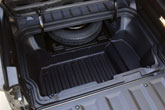
Notes
Test Vehicle: 2006 Honda Ridgeline RTL and RTS MSRP Price Range: $27,770 to $31,490 Engine Size and Type: 3.5 liter V6 Engine Horsepower: 255 Engine Torque: 252 EPA Fuel Economy (city/highway): 16/21 Curb Weight: 4,494 pounds Competitors: Toyota Tacoma, Dodge Dakota, Ford Explorer SportTrac, Nissan Frontier, Chevrolet Colorado, GMC Canyon, Chevrolet Avalanche